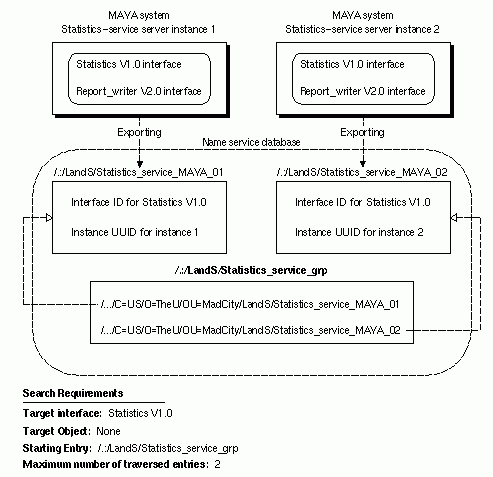
With the service model, when multiple server instances on a given host are somehow unique, each instance must export to a separate server entry. The exported binding information must contain one or more instance-specific, well-known endpoints or an instance UUID. Well-known endpoints and instance UUIDs are used under the following circumstances:
· Well-known endpoints
An instance-specific, well-known endpoint must be provided to a server instance as part of its installation; for example, as a command-line argument. Before calling the export operation, the server instance tells the RPC runtime to use each of its well-known endpoints; it does this by calling rpc_server_use_protseq_ep( ). The runtime includes these endpoints in the instance's binding information, which the runtime makes available to the instance via a list of server binding handles. The server instance uses this list of binding handles to export its binding information, including the well-known endpoints. The server also uses this list of binding handles to export its well-known endpoint with the local endpoint map; it does this by calling rpc_ep_register( ) or rpc_ep_register_no_replace( ). Remote calls made using an imported well-known endpoint from a server entry are guaranteed by the RPC runtime to go only to the server instance that exported the endpoint to that entry.
Note: Only one server instance per system can use a well-known endpoint obtained from a given interface specification.
· Instance UUID
Create an instance UUID only for a new server entry. Generating a new instance UUID each time a server instance exports to a server entry will result in many instance UUIDs that are difficult to manage and may affect performance as new instance UUIDs are constantly added to server entries. If a new server instance inherits a currently unused server entry left behind by an earlier instance, before exporting, the new server instance should inquire for an instance UUID in the server entry; this is done by calling the rpc_ns_entry_object_inq_{begin,next,done}( ) routines. If the inherited entry contains an instance UUID, the server uses it for an instance UUID, rather than creating and exporting a new instance UUID. If an inherited entry lacks an instance UUID, however, the server must create a UUID and export it to the server entry.
Note that every server instance must register its instance UUID along with its endpoints in the local endpoint map.
Note: Using an instance UUID precludes any other use of object UUIDs for the application.
The following figure shows distinct instances of a statistics-service server on the same host. Each server instance uses an instance UUID to identify itself to clients. The instance UUID is the only object UUID a server instance exports to its server entry. Starting at the statistics-service group, clients import the statistics interface.
After finding a server entry with compatible binding information for the statistics interface, the import operation returns an instance UUID along with binding information. Every remote procedure call made with that binding information goes to the server instance that exported the instance UUID.
Service Model: Distinct Instances on One Host
